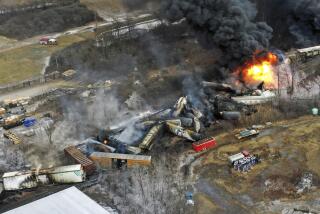Make the rails safer
- Share via
Regardless of what caused last week’s deadly Metrolink crash in Chatsworth, there is new technology -- in use elsewhere but never installed in Southern California -- that probably could have prevented the disaster. Positive train control systems use global-positioning-system and digital-communications technology to determine when a train is in a dangerous situation, send out warnings and slow or stop it remotely.
In test projects across the nation, positive train control has not only made rail transportation safer, but more efficient. Trains can travel faster and closer together when computers analyze possible hazards.
Railroad companies have legitimate concerns about the high-tech systems. They’re imperfect (signals can be lost in tunnels or remote canyons, for example) and expensive. But the technology is improving rapidly, and the Federal Railroad Administration predicts that within five years any significant kinks will have been worked out.
Federal rail-safety legislation passed by the House of Representatives would require major railroad companies to install positive train control by 2014, but the bill does little to ease the financial burden, estimated at $2.3 billion nationwide. Considering that the federal government has an interest in rail safety, increased use of public transportation and the installation of a uniform interstate system, it should provide matching funds. Commuter rail systems should share the costs as well. And Metrolink, which has the second-worst commuter-rail fatality record in the nation, and not coincidentally shares an unusually high proportion of its tracks with freight trains, should receive one of the federal grants for a test installation.
Catastrophe often serves as a catalyst for change. The 2005 Metrolink crash near Glendale, in which 11 people were killed, gave rise to a new emergency-response system that was implemented successfully Friday, using helicopters to bring victims to more hospitals so that no single emergency room was overwhelmed. Mayor Antonio Villaraigosa’s well-intentioned train trip Monday, to demonstrate his faith in Metrolink’s safety, won’t be nearly as effective as installing state-of-the-art technology.
More to Read
A cure for the common opinion
Get thought-provoking perspectives with our weekly newsletter.
You may occasionally receive promotional content from the Los Angeles Times.









